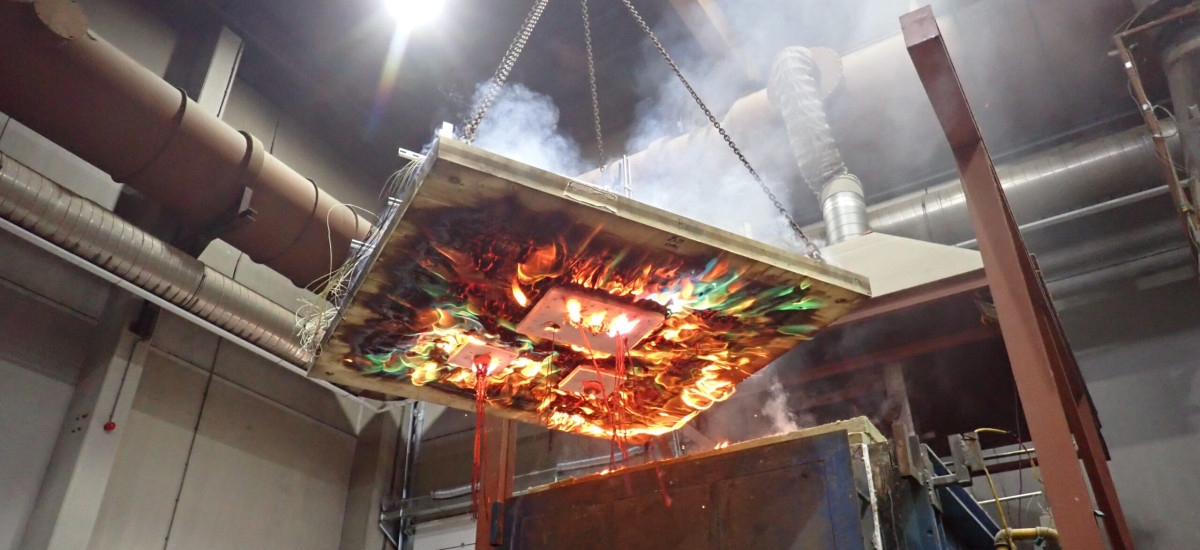31/10/2025
Once again, a special series of fire tests took place at Efectis. At the beginning of September, CLT ceiling elements with vertical installation penetrations from VDL De Meeuw were tested. These elements are part of the biobased modules of De Meeuw. All variants achieved a fire resistance of at least 60 minutes.
VDL De Meeuw uses CLT in its biobased modules for residential construction, among other things. These biobased modules can be fitted with a 90 mm thick CLT ceiling. This results in a cavity between the top of the module and the bottom of the next module (space between the ceiling and the structural floor) of several centimeters. This cavity can be used for electrical cables for lighting points.
For the power supply of fixtures or perhaps junction boxes in the ceiling, feed-throughs to the cavity are required. Installation feed-throughs are also required for standpipes, such as for a meter cupboards and waste water drainage pipes. But what does this mean for the fire safety of the entire structure between ceiling and next floor?
Fire resistant penetrations
We used the fire test to see whether the penetrations could prevent the spread of fire to the cavity. If the fire reaches the cavity, it will affect the floor above. A cavity fire is also hard to extinguish, even though the cavity is sealed on all sides.
Due to time constraints the customer wanted an exploratory test of the fire resistance of the penetrations – not the entire element – a smaller oven was chosen. This oven can be used to test elements measuring up to 2 x 2 meters. The test piece measured 1.8 x 1.8 meters.
In order to conduct an official test, the CLT ceiling element would have needed to measure at least 4 x 2 metres. In addition, two free edges would have been required, and the installation support structure would have had to be supported on the test frame in such a way that the pipes could move independently of each other in relation to the CLT ceiling element. This is only possible on the large oven. The results of this smaller exploratory test will enable the customer to carry out an assessment.
The penetrations are fitted with a fire stop product that foams up in the event of a fire. It is important that if the underside of the ceiling delaminates, the fire stop product continues to seal the penetration. In this situation, the customer opted to protect the CLT ceiling element locally with plasterboard and to mount the fire collar on top of this. In addition, the length of the screws used to attach the fire collars and plasterboard is also important. Delamination must not cause the screws to come loose. The manufacturer of the fire-resistant products was therefore present during installation to work with VDL-De Meeuw and arrive at a reliable design.
Rainbow-coloured flames could be seen during the test. This is because formaldehyde was released from the CLT. This is contained in the adhesive used to bond the lamellas together.
Test result
The penetrations in the CLT ceiling element proved to have very good fire resistance. The tests were carried out in accordance with NEN-EN 1366-3 “Determination of the fire resistance of installations – Part 3: Seals for penetrations”. Eurocode 5 “Design and calculation of timber structures” was also considered. An overrun time of 8 minutes was applied. The test piece was then lifted out of the oven. After this, the ceiling elements with penetrations were found to have passed the test. The results are incorporated into a test report and a separate expert assessment is provided. This allows VDL-De Meeuw to claim a fire resistance of 60 minutes.
These types of exploratory tests are also used by customers during product development to see whether the right direction has been chosen. We can then quickly provide insight into the test results. Ultimately, in timber construction, we must avoid using oversized components to meet fire resistance requirements. This can lead to material obesity, which is not sustainable. Good fire tests can help customers to optimize their use of materials.
For more information, please contact Jerry Huijsman or Cindy Beckers

